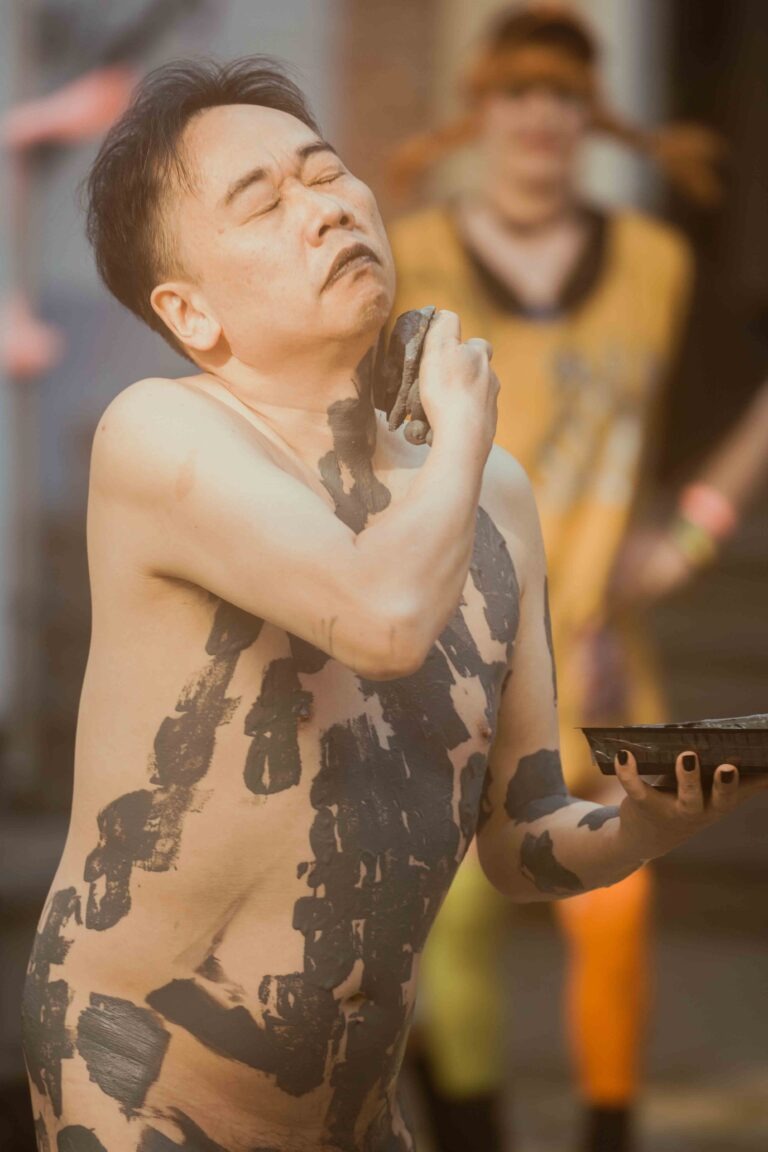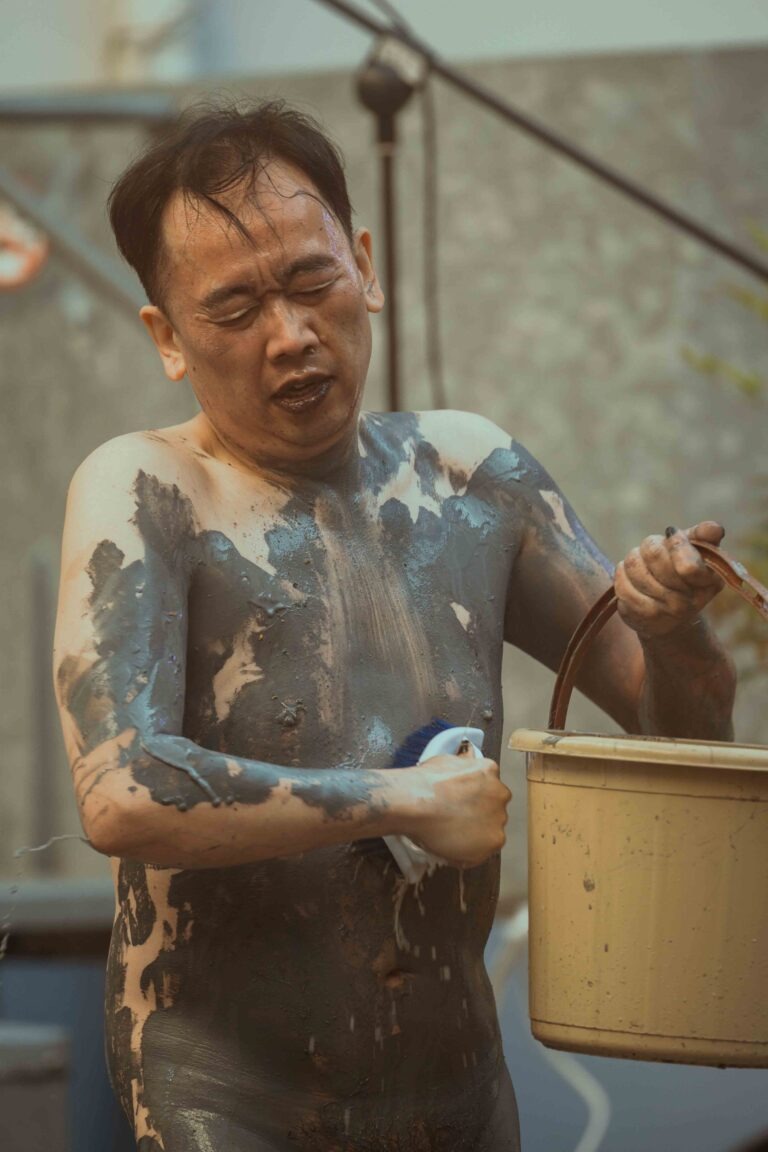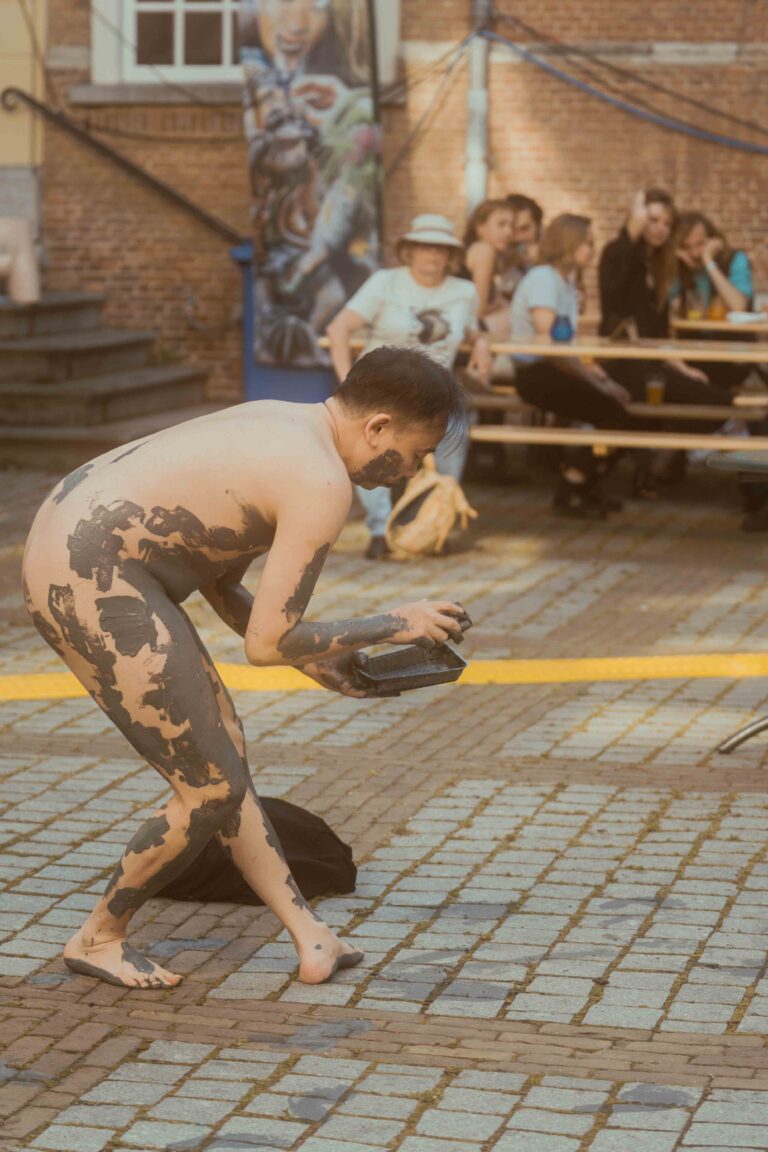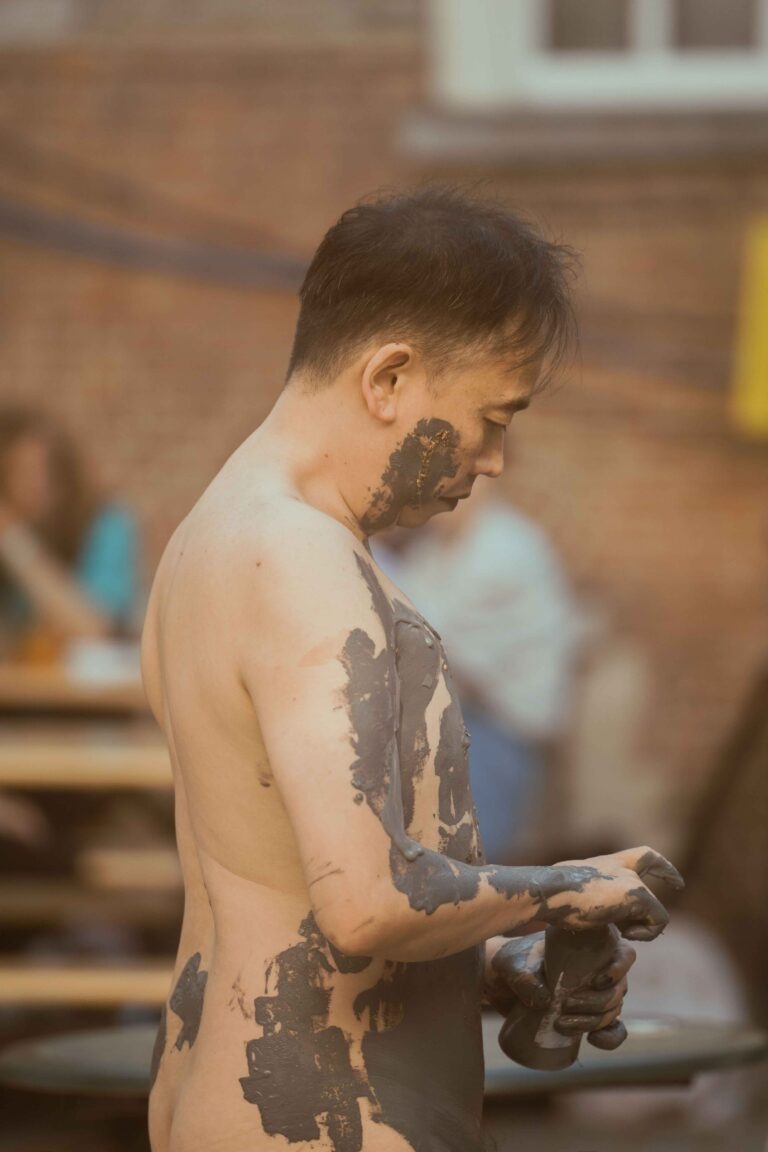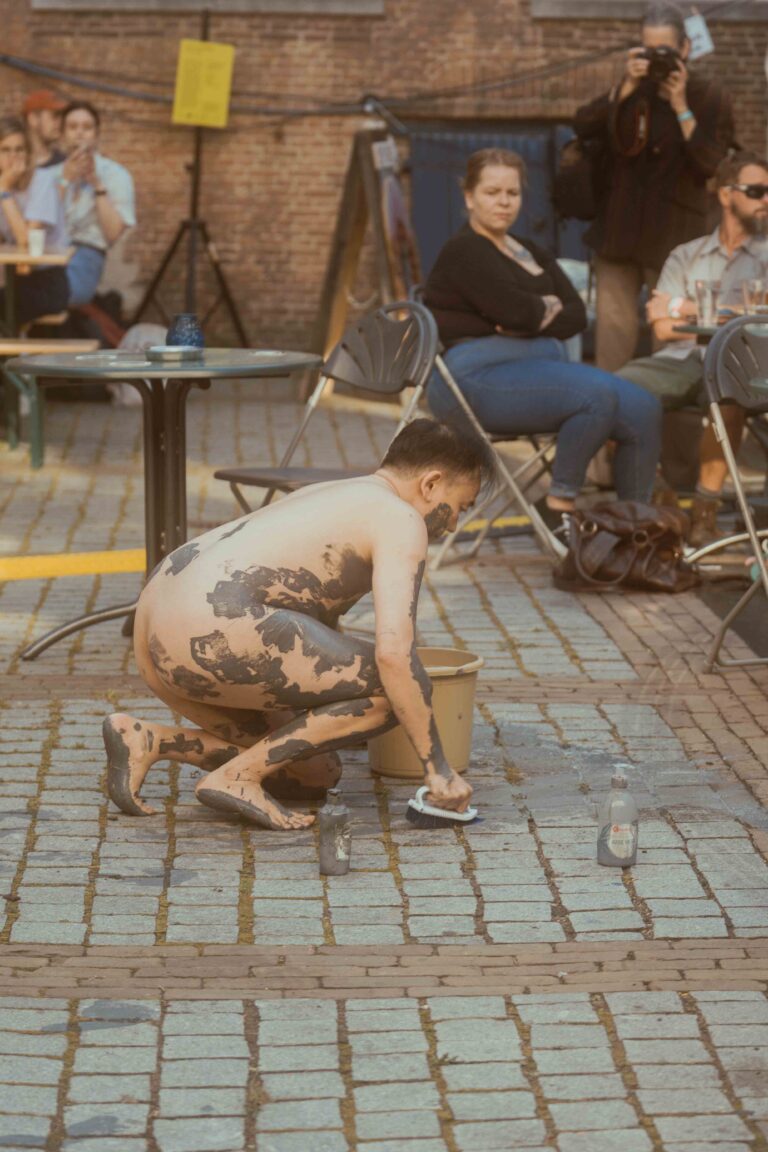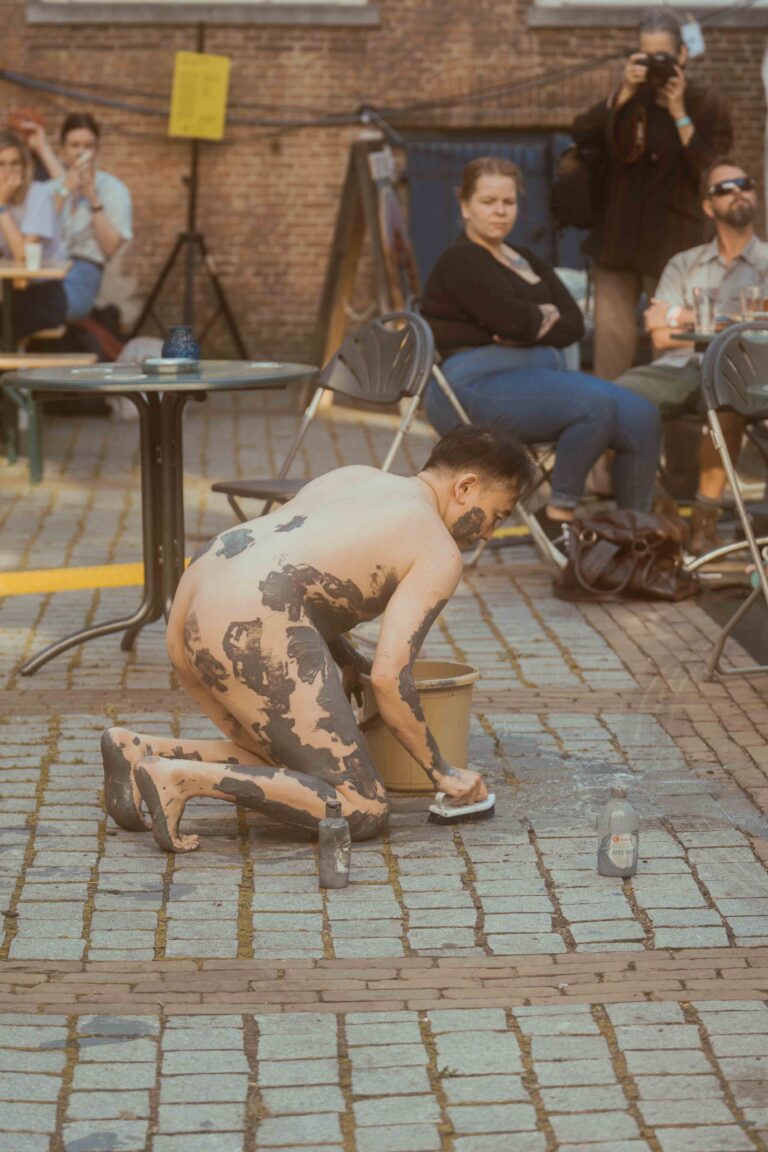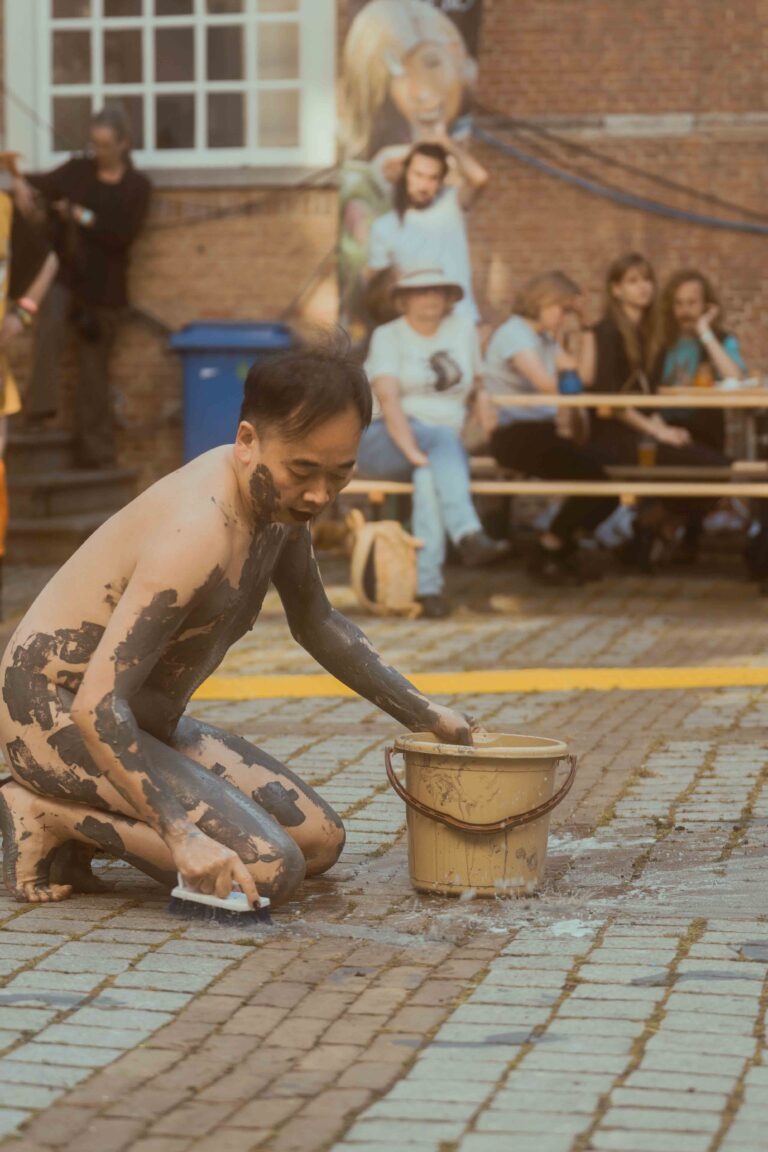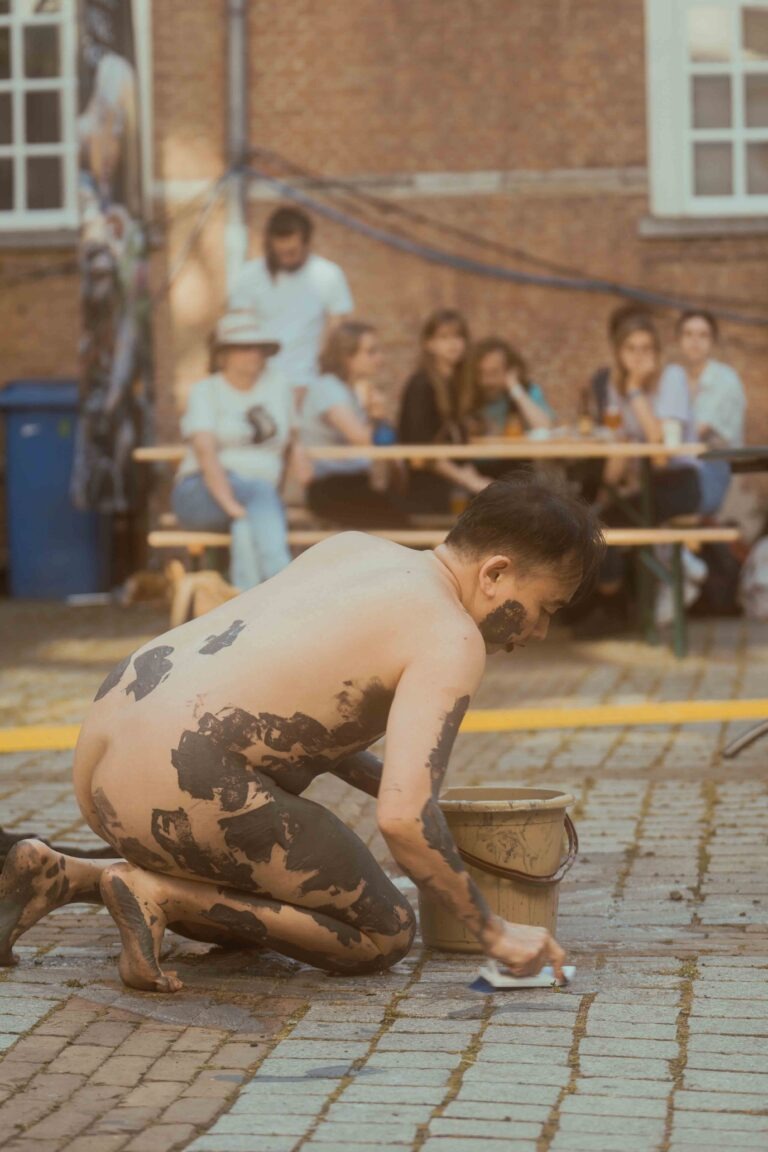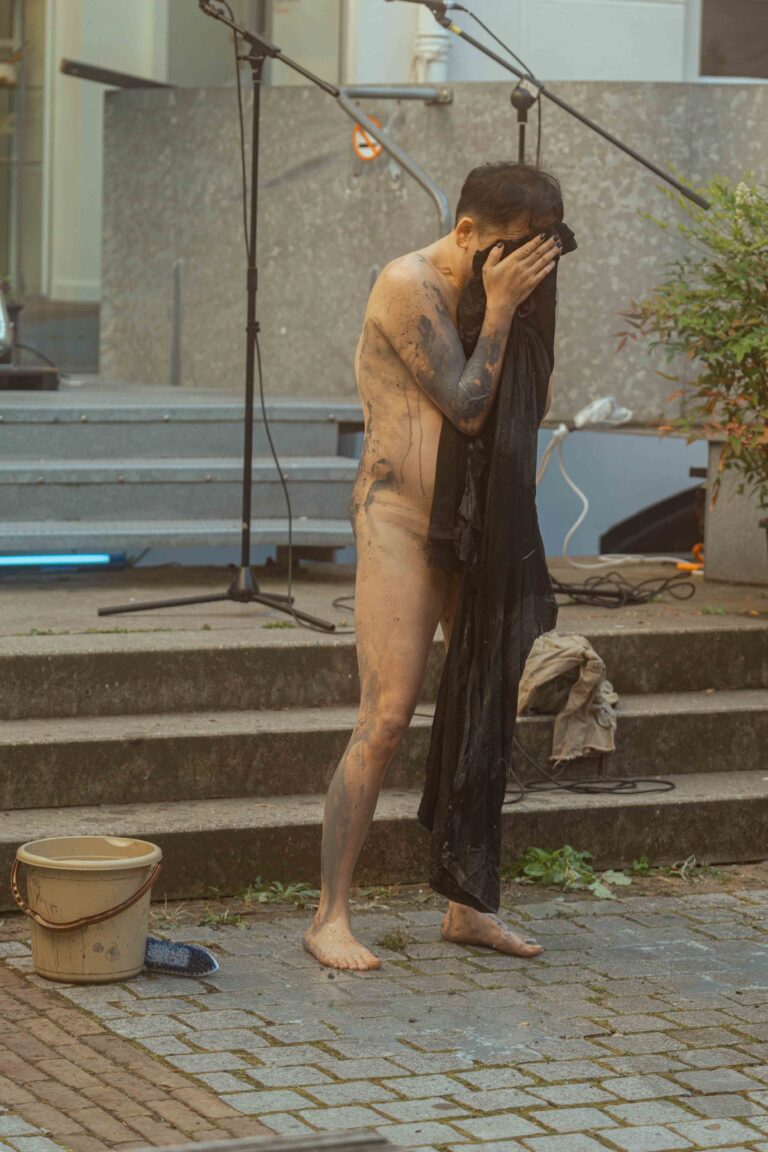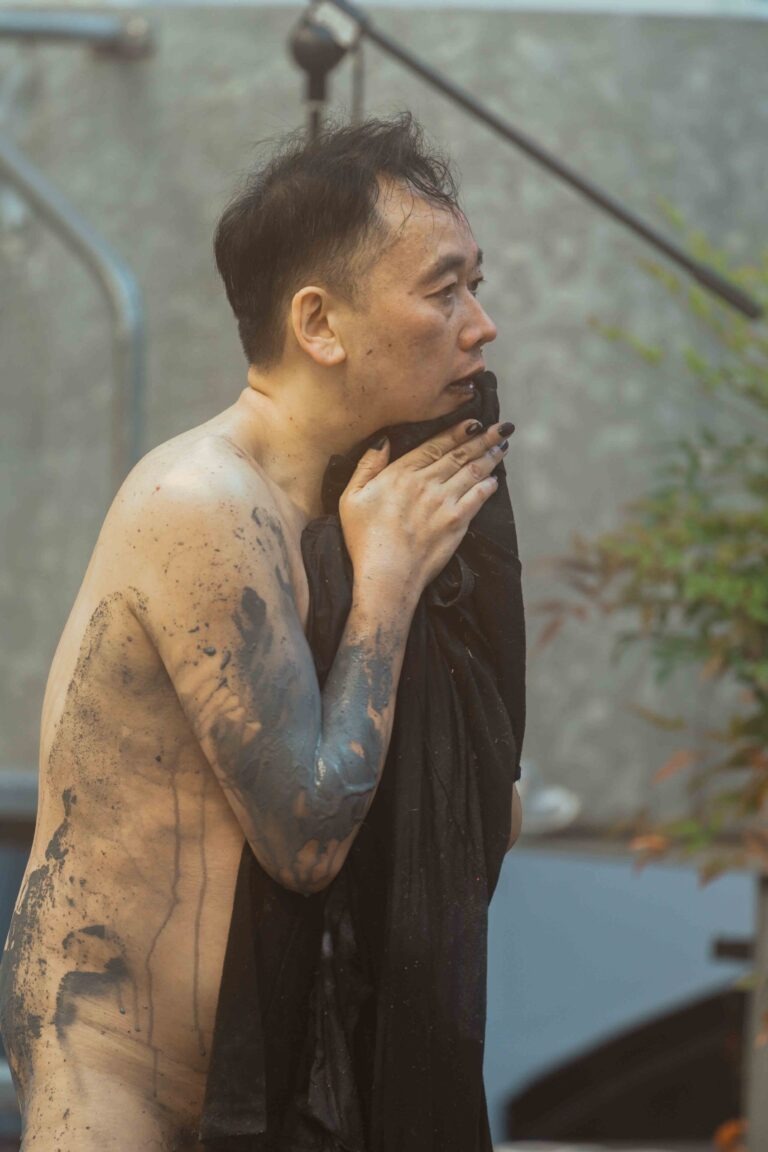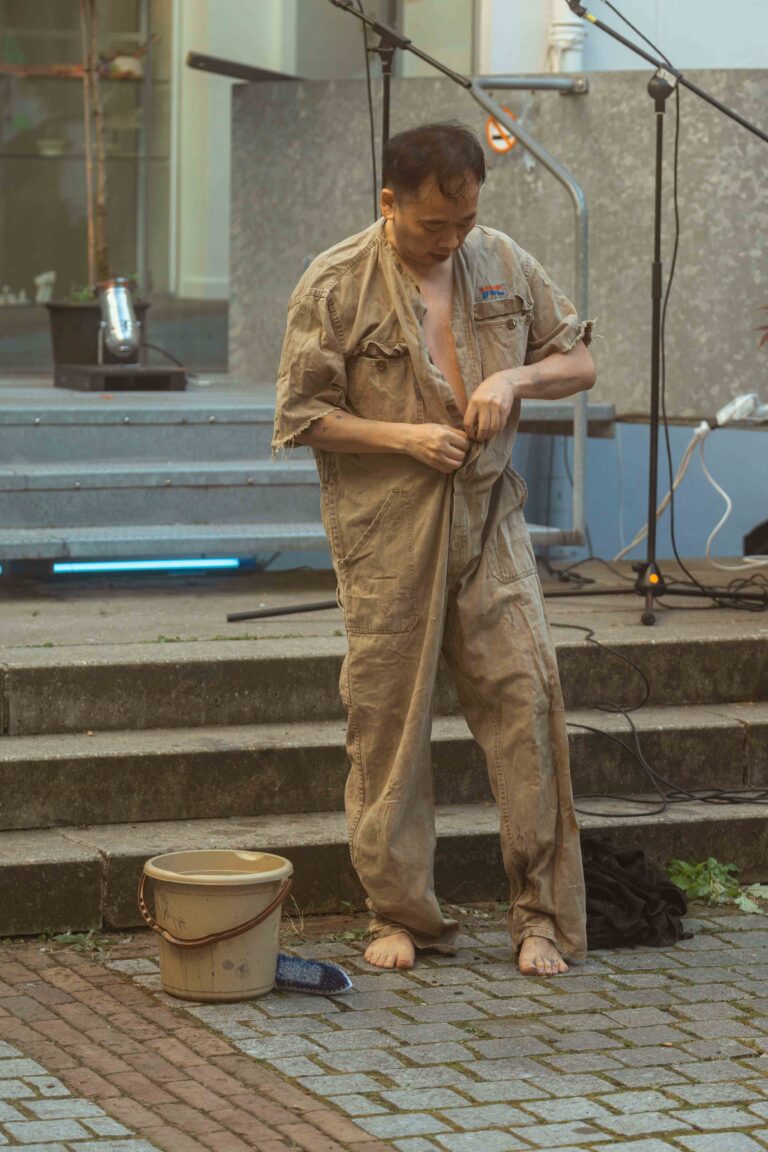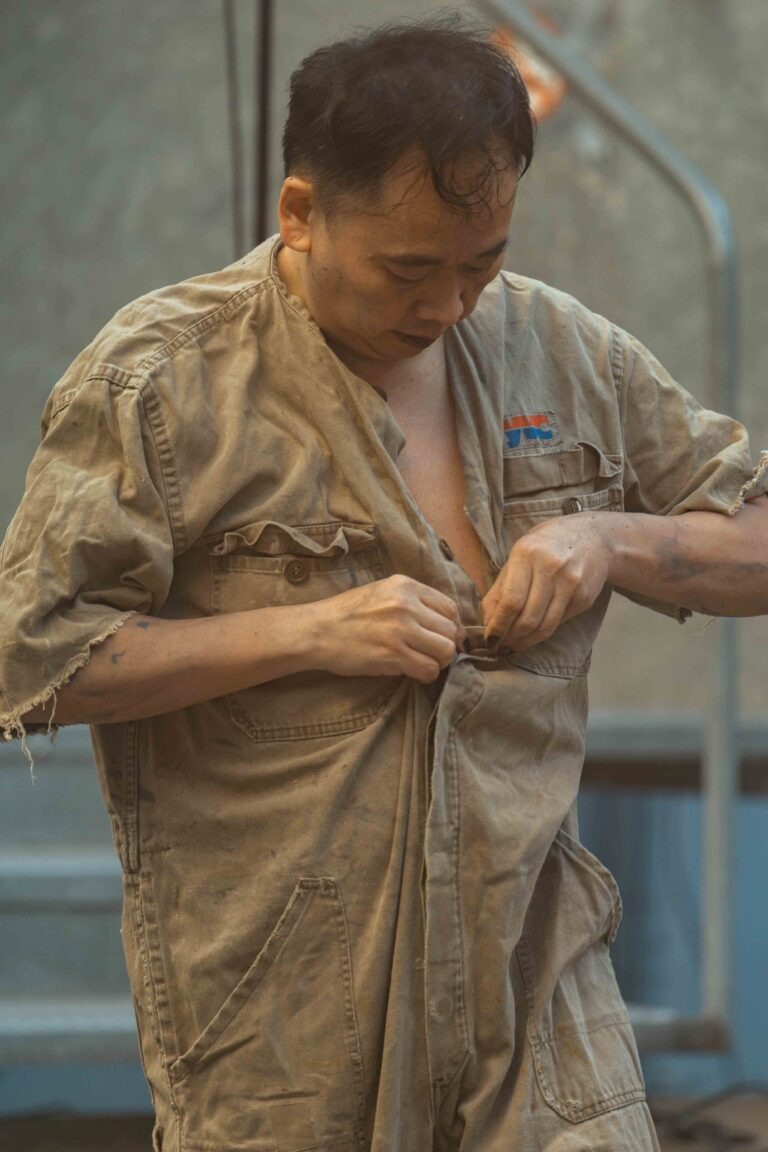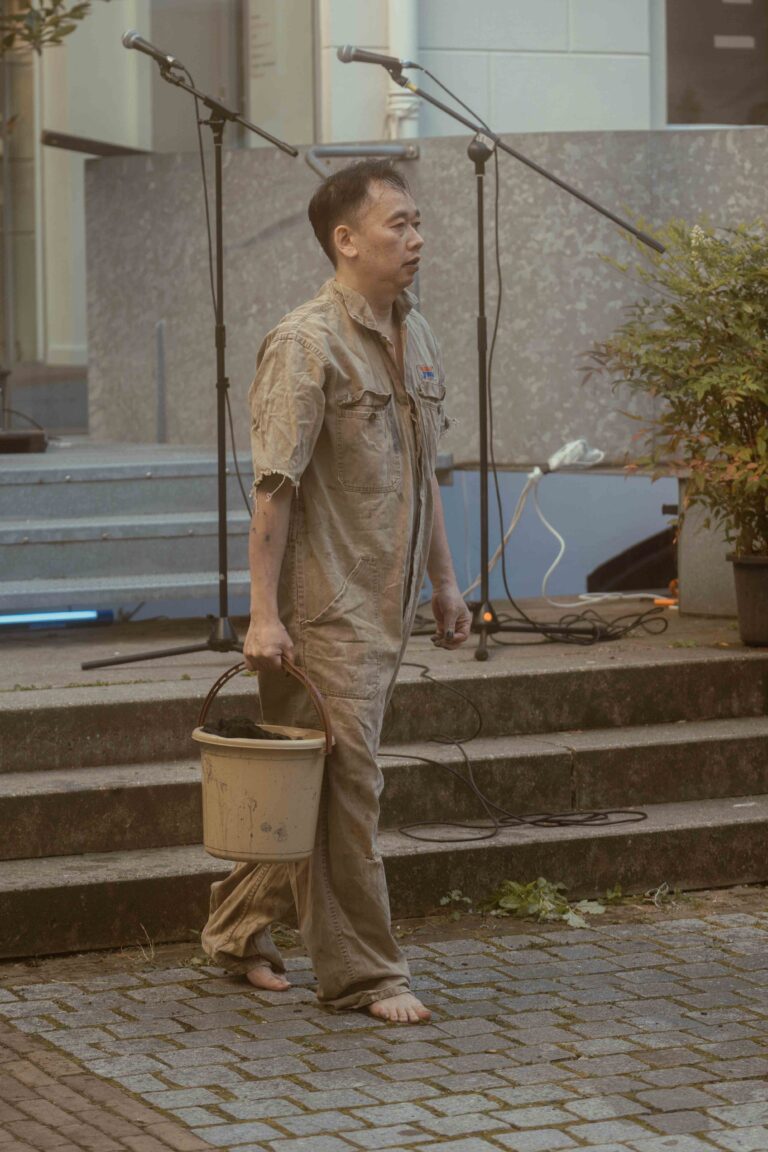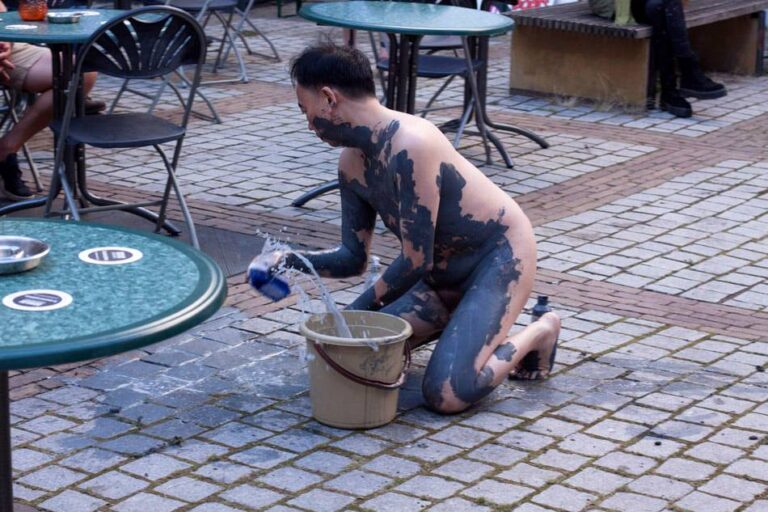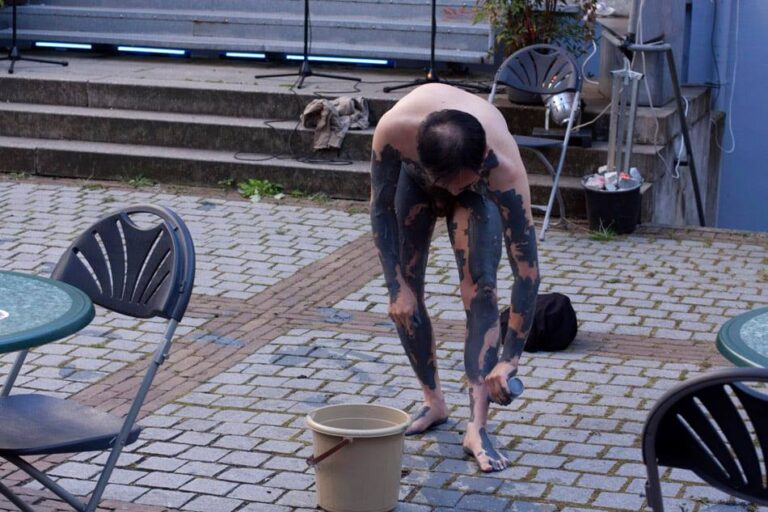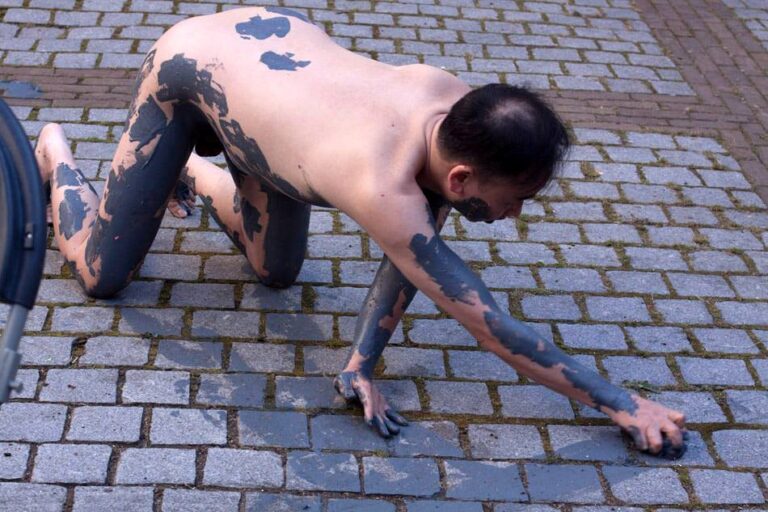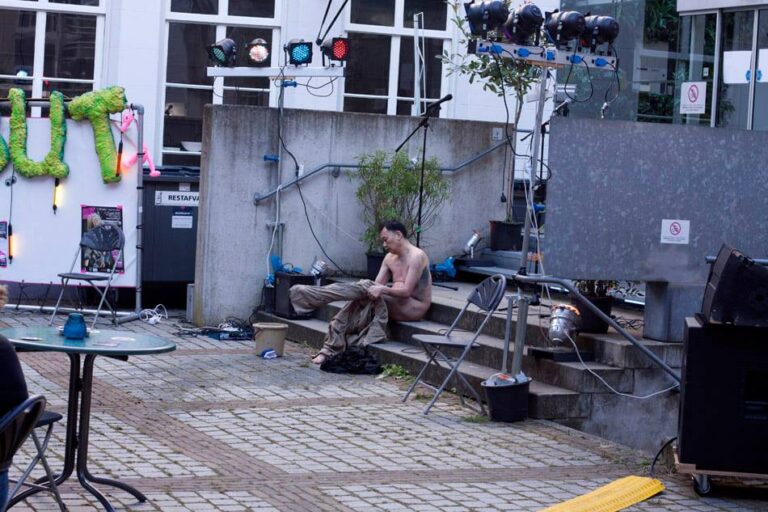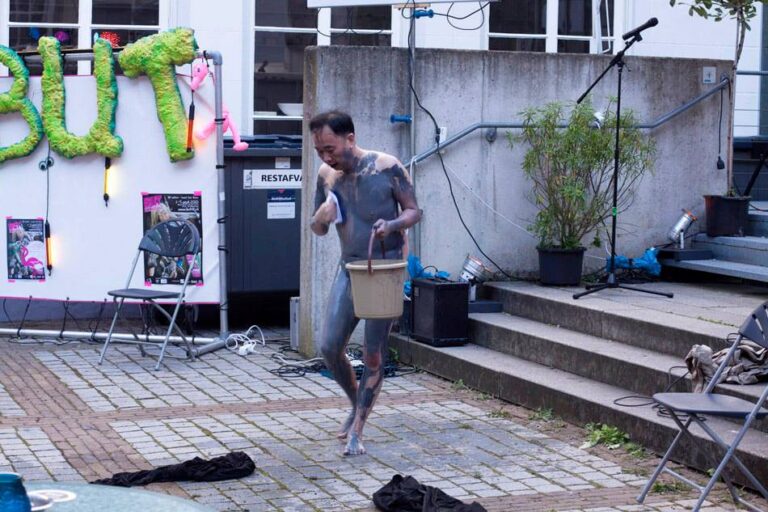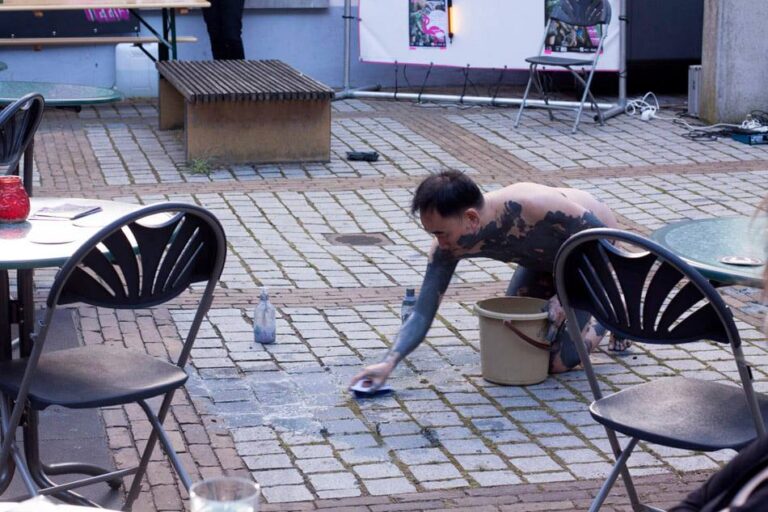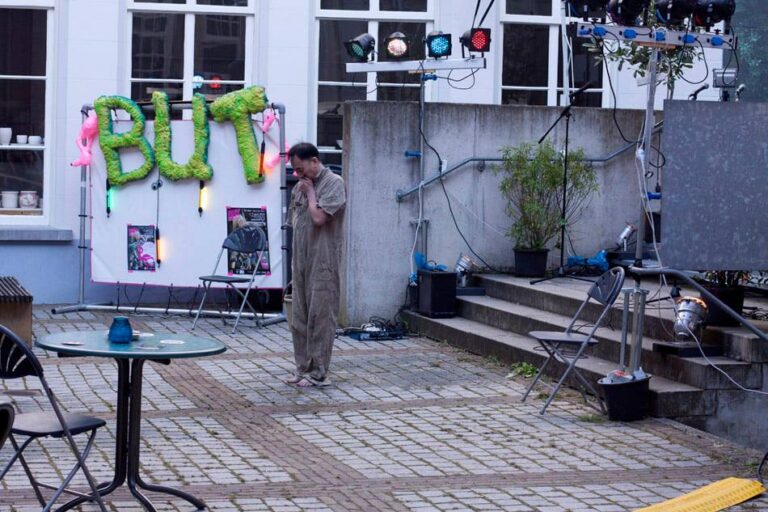Transition (2021)'15 Philemon Mukarno Performance
Transition: A Naked Performance Art by Philemon Mukarno
Transition: Philemon Mukarno’s Naked Deconstruction of Faith at BUTFF 2021
Context and Setting: Breda’s ‘Sweet Sick Teens’
The Festival of Rebellion and Identity
Philemon Mukarno presented his seminal performance Transition on September 5, 2021. The celebrated setting was the BUT Film Festival (BUTFF) in Breda, Netherlands. This event marked the festival’s 16th annual edition. The BUTFF consistently champions B-Film, Underground, and Trash arts.
The festival provides a critical platform for unique, uncensored views on complex social issues. Furthermore, this year’s central theme was the explicitly titled ‘Sweet Sick Teens’. This framework explored the difficult, turbulent phase of adolescent identity formation.
Consequently, the theme focused on the unsteady shift from childhood innocence to adult responsibility. The thematic architecture perfectly framed Mukarno’s intense exploration of personal liberation. Transition therefore, functioned as an aesthetic echo of the festival’s core concern with radical self-discovery.
The 16th Edition: Celebrating Turbulence
Sixteen is an age carrying profound cultural weight in many societies. It often signifies the “sweet sixteen” milestone of growing autonomy and boundary testing. BUTFF celebrated its institutional adolescence by focusing on this turbulent age.
The festival highlighted classic adolescent struggles, including moral dilemmas and peer pressure. Additionally, it emphasized the inherent struggle to define one’s identity against inherited societal expectations. This essential rebellion against rigid frameworks is central to the ‘Sweet Sick Teens’ theme.
Mukarno’s work directly addressed his own experience with religious indoctrination during childhood. This profound act of breaking free mirrored the universal struggle against externally imposed structures. His personal journey thus became a universal metaphor for psychological maturity and self-authorship.
Performance Art in the Underground Film Space
The BUTFF mandate permits art produced with a low budget yet offering powerful, uncensored perspectives. This inclusive environment allowed for the raw, uncompromising nature of Transition to be fully expressed. Mukarno’s performance, exploring themes of nudity, sexuality, and the body, aligns perfectly with this mandate.
Festival locations included the Culture Centre de Nieuwe Veste and the Chassé Theater. The placement within this fringe arts festival ensured the performance reached a receptive and critically engaged audience. The Breda festival environment permitted an intense exploration of human expressiveness.
The synchronicity between the performance title, Transition, and the festival theme is intentional. This deep connection suggests a conscious curatorial alignment. Ultimately, the setting magnified the personal stakes of Mukarno’s performance art piece.
Philemon Mukarno: Composer of Spirit and Form
Establishing the Artist’s Authority
To properly analyze Transition, one must first acknowledge Philemon Mukarno’s rigorous artistic foundation. He is recognized as an Asian performance artist and a highly trained composer. He is currently based in Rotterdam, where he continues his diverse practice.
Mukarno possesses distinguished academic credentials. He intensively studied composition and electronic music at Codarts and the Royal Conservatory of The Hague. This period of focused study culminated in a Cum Laude graduation.
Furthermore, he was awarded the prestigious Prize for Composition, firmly establishing his technical reputation. This distinguished background confirms that his performance art is rooted in intellectual rigor and precise execution. His projects are therefore structured conceptual endeavors, not merely random acts of sensationalism.
Means and Form: The Art of Intense Expressiveness
Mukarno is frequently described as a unique and utterly uncompromising figure in Contemporary Art. His established creative methodology relies on a “strong economy of Means”. This efficiency is strictly balanced by a commitment to a “strict control of Form”.
He employs elementary but powerful methods to achieve intense expressiveness in his varied works. His formal training in music composition, which demands structural precision, dictates his approach to body art. Therefore, even emotional chaos is meticulously channeled through a controlled formal structure.
Consequently, all shocking elements, such as public nudity or the black ink, are deliberately chosen ‘means’. These elements are deployed to achieve a tightly controlled ‘form’ of personal liberation. This careful approach elevates the artistic merit far above simple provocative intent.
The Body as the Ultimate Instrument
Mukarno frequently integrates his own body as one of his principal artistic trademarks. He approaches this corporeal medium with the same sense of spirituality that fuels his musical compositions. The performance becomes a profound investigation of the human body itself.
He uses the body to explore its deep subconscious processes and energy. His work delves into the “density and complexity of the human structure,” including raw physicality and thought processes. For Mukarno, external objects are simply matter or tools.
The true artistic focus remains fixed on the mental and spiritual dimension. Thus, in Transition, the body acts like a musical score. It presents a sequence of prescribed, ritualistic movements, demonstrating the composer’s control over his newest medium.
The Conceptual Canvas: Defining Transition
Breaking Free from Indoctrination
The entire emotional drive of Transition stems from the artist’s reflection on religious indoctrination. This conditioning occurred during his impressionable childhood years. The performance provides a powerful, visual expression of his intense desire to sever these ties.
This highly personal investigation targets internalized frameworks that fundamentally “warped” his self-image. The explicit artistic purpose is defined as seeking to “destroy frameworks”. This necessary phase of destruction prepares the artist for a “new beginning”.
The piece functions as a critique of how external, rigid belief systems can actively confuse or desensitize the individual. Ultimately, the core goal is achieving complete psychological and spiritual self-authorship.
Vulnerability as the Primary Medium
Mukarno utilizes public nudity not for cheap theatrical shock, but as a critical expressive tool. Nudity in his artistic practice signifies a “natural and honest state of being”. It forcefully strips away all protective societal masks and pretenses.
This raw exposure reveals intense vulnerability, functioning as the performance’s primary medium. Mukarno openly invites the audience to observe and empathetically connect with his intensely private emotional journey. His central objective is to foster an authentic connection between the performer and the observer.
The artist presents his exposed form as “Nude, Bare, Naked, Raw, and Real”. This powerful, visual declaration reclaims the body as the ultimate site of truth and honesty.
Challenging Societal Nude Taboos
Transition explicitly challenges the stringent norms and taboos surrounding public nudity. This confrontation is particularly sharp when nudity intersects with religious dogma. Many religious traditions associate public nakedness with shame, sinfulness, and degradation.
By performing the ultimate act of liberation while naked, Mukarno reclaims the body from imposed theological shame. He deliberately transgresses the boundaries dictated by these controlling doctrines. This intentional contradiction generates a powerful artistic tension.
The use of the most shameful state, public nudity, performs the most sacred act of self-cleansing. Consequently, this performance asserts fundamental ownership over his physical and spiritual self. It transforms what is traditionally perceived as vulnerability into a potent, transgressive declaration of autonomy.
The Ritual of Marking: Inscription and Imprint
The Weight of Faith in Black Ink
The performance unfolds as a highly structured, three-part ritualistic process. The critical initial phase involves the meticulous stamping of religious symbols onto Mukarno’s naked body. Black ink is deliberately chosen for this painful inscription.
The black ink visually represents the heavy, indelible nature of indoctrination. This action simulates the external force that imposed these rigid beliefs onto the self. Historically, permanent body markings, like tattoos, convey profound spiritual meanings.
However, when these symbols are imposed without true, conscious consent, they function as marks of oppression. Mukarno co-opts this process to document his trauma. The physical stamping action externalizes the internalized psychological conditioning he suffered.
The Body as Palimpsest
During this complex phase, the artist’s body transforms into a living palimpsest. It details a literal history of prescribed faith. He covers himself with various, sometimes conflicting, signs of faith. This dense layering suggests the overwhelming and confusing burden of inherited beliefs absorbed in childhood.
The performance consciously uses the body to articulate his awareness of these complex inner processes. These applied marks act as temporary, performative tattoos. They underline the ongoing debate concerning the spiritual sanctity of the human form.
For Mukarno, the physical presence of the black ink represents the sheer density of these restrictive belief systems. The meticulous, systematic application confirms that the struggle is controlled and carefully documented.
The Imprint Left Behind
Following the thorough inscription, Mukarno transitions into the second, documentary phase. He lies down flat, intentionally pressing the inked symbols against the surface of the ground. This pressure creates a clear, physical “imprint of his body on the floor”.
This critical step symbolizes the inescapable, lingering trace of his religious history in the world. Furthermore, the imprint physically documents the mental and spiritual weight he carried while marked. It serves as a tangible record of the imposed identity he is actively shedding.
When the artist finally rises, the shadow of the imprint remains lingering on the floor. This shadow documents the past, indoctrinated self that he consciously chooses to abandon. The resulting body print is a forensic document confirming the reality of his former spiritual burden.
Sacred Cleansing: The Pursuit of Self-Erasure
The Cleansing Counter-Ritual
The third and culminating action provides the necessary resolution to the performance’s narrative. This final act involves Mukarno washing himself completely. Critically, he uses ‘holy water’ to achieve this symbolic absolution.
This self-administered ritual explicitly cleanses both his “body and soul”. It seeks to remove the final “traces of religion” that were imposed upon him. This final structured act of self-care completes his desire for total freedom.
The process visually moves the artist from a painful state of inscribed trauma toward a state of spiritual purity. This organized act of de-indoctrination is the defining moment of the piece’s resolution.
Holy Water: Symbolic Absolution and Renewal
The use of ‘holy water’ is profoundly significant, establishing a meta-commentary. This element is theologically potent, traditionally associated with baptismal renewal. Additionally, it is linked with the cleansing of venial sin and protection against evil forces.
Mukarno deliberately re-appropriates this powerful symbol of sacred protection. However, he directs its power toward protecting himself from the very faith that weaponized it. This calculated act of subversion elevates the performance to complex critical analysis.
The cleansing functions as an auto-baptism. It is a powerful self-declaration of a new, secular spirituality rooted in personal self-awareness. This controlled conclusion resolves the intense expressiveness established during the marking phase.
A Rite of Passage Toward a New Beginning
The cleansing completes Mukarno’s deeply personal Transition. This moment directly aligns with the BUTFF theme of radical, necessary change. The artist intends to leave the confines of his past comfort zone entirely.
He seeks to project new shapes of identity originating from his own inner spirit. The entire performance thus functions as a radical rite of passage. This passage is toward self-awareness and self-authorship, marked by the powerful erasure of the ink.
The journey is described by Mukarno as vulnerable, deliberately dark, and intensely sensual. It achieves its purpose as a step toward psychological repair and preparation for the future. The naked body that was symbolically marked by religion is now entirely unmarked by its influence.
Critical Reception and Enduring Impact
Inspiring Dialogue on Belief and Identity
Transition serves as a powerful catalyst for urgent public dialogue. It raises immediate, critical questions about the role of inherited religious structures in contemporary society. The critique moves beyond simple rejection to complex cultural commentary.
Mukarno uses his exposed, naked body to forge an unflinchingly honest connection with the observers. This raw, public vulnerability compels viewers to confront the performance directly. Consequently, passive judgment is often swiftly replaced by empathy for his journey.
The work compels serious reflection on who holds ultimate ownership over the body and its spiritual narrative. The performance intimately explores the human structure and its complex thought processes.
A Bold Statement Against the Status Quo
The piece has been consistently characterized as a “bold and brave statement”. Mukarno’s aesthetic style is renowned for being utterly uncompromising. This deliberate approach guarantees a high level of critical excitement for the work.
The structure of the piece creates a “monolithic aura” that demands full attention. Transition challenges deeply entrenched conventional norms and inspires revolutionary change in thinking. It directly questions the suffocating forces of the status quo.
Mukarno deliberately seeks to counteract societal traps designed to confuse or actively desensitize individuals. The boldness of public nudity, combined with potent religious symbolism, makes the critique sharp and unavoidable.
The Freedom of Human Expression
Ultimately, the performance stands as a powerful celebration of human diversity and self-determination. It champions radical freedom of personal expression, regardless of one’s background or inherited belief. Mukarno’s dual identity as an Asian artist based in Europe adds critical context.
His critique of religious indoctrination consequently gains intense global resonance. It transcends a local Western critique, addressing global patterns of spiritual control and imposition.
The work confirms the enduring, visceral power of live body art. This unique art form is fundamentally capable of communicating complex, deep inner truths. The entire execution centers on achieving authenticity and defying harmful societal expectations.
Legacy of the Unmasked Artist
Authenticity in Contemporary Art
Transition showcases Philemon Mukarno’s undeniable artistic expertise. The performance successfully marries the technical rigor of his compositional training with profound emotional depth. The controlled ritualistic structure confirms his capacity for strict formal control.
His effective use of the naked body as a vulnerable, honest medium secures his place among leading performance artists. The careful execution suggests the subject is handled with rigorous intention.
By detailing his Cum Laude training and his uncompromising aesthetic, the artistic merit is fully validated. The performance is clearly the product of a sophisticated, intentional, and technically informed creative process.
Transition remains a crucial reference point in 21st-century body performance art. The work functions as a powerful, rigorously structured meditation on the difficult necessity of self-liberation. It profoundly synthesizes Mukarno’s compositional skills with his chosen corporeal expression.
The naked body served as the ultimate canvas and site of internal conflict. It was initially marked by external imposition. However, it ultimately became the site of spiritual resolution through structured, ritualized cleansing. This makes Transition a timeless piece about confronting heritage to achieve true authenticity.
The enduring legacy of the performance lies in its commitment to vulnerable truth. It uses exposed vulnerability as a means to powerfully define personal strength. Ultimately, it inspires all viewers to confront their own inherited frameworks and seek their own radical spiritual freedom.

